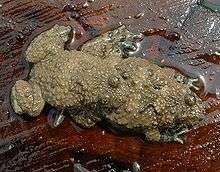Bombinatoridae
Bombinatoridae is a family of toads found in Eurasia. Species of the family have flattened bodies and some are highly toxic.
| Bombinatoridae | |
|---|---|
 | |
| Bombina variegata | |
| Scientific classification | |
| Kingdom: | Animalia |
| Phylum: | Chordata |
| Class: | Amphibia |
| Order: | Anura |
| Suborder: | Archaeobatrachia |
| Family: | Bombinatoridae Gray, 1825 |
| Genera | |
|
See text | |
| Distribution of Bombinatoridae (in black) | |
Taxonomy and systematics
Fossil specimens of the genus Bombina are known from the Pliocene to the Pleistocene. The earliest fossil specimens are Eobarbourula from the Eocene of India, and Hatzegobatrachus from Late Cretaceous of Hateg island, Romania. The genus Barbourula was considered to be situated intermediate between Discoglossus and Bombina, but closer to the latter, so was added to the Bombinatoridae when that family was split from the Discoglossidae.
Genera
Currently, there are two extant and at least two extinct genera recognised in the family Bombinatoridae:[1]
- Barbourula (Taylor and Noble, 1924) - jungle toads
- Bombina (Oken, 1816) - firebelly toads
- †Eobarbourula Folie et al., 2012
- †Hatzegobatrachus Venczel & Csiki, 2003
Description
Bombina species are warty, aquatic toads about 7 cm (2.8 in) in length, and most noted for their bright bellies. They often display the unken reflex when disturbed; the animal will arch its back and limbs to expose the bright belly, and may turn over on its back. This acts as a warning to predators.[2] The vocal behavior of some Bombina species are unusual in that the call is produced during inhalation rather than exhalation as in other frogs. They lay pigmented eggs in ponds.
Distribution and habitat
Species of the genus Barbourula occur in the Philippine Islands and Borneo, while species of the genus Bombina are found throughout Eurasia. They are slightly less colored than Bombina spp., and possess webbed fingers in addition to webbed toes. Characteristics of tadpoles of Barbourula spp. are unknown.
References
- Bombinatoridae at the American Museum of Natural History's Amphibian Species of the World website
- Zweifel, Richard G. (1998). Cogger, H.G.; Zweifel, R.G. (eds.). Encyclopedia of Reptiles and Amphibians. San Diego: Academic Press. pp. 85–86. ISBN 0-12-178560-2.
- San Mauro, Diego; Mario Garcia-Paris; Rafael Zardoya (December 2004). "Phylogenetic relationships of discoglossid frogs (Amphibia:Anura:Discoglossidae) based on complete mitochondrial genomes and nuclear genes". Gene. 343 (2): 357–66. doi:10.1016/j.gene.2004.10.001. PMID 15588590.
- San Mauro, Diego; Miguel Vences; Marina Alcobendas; Rafael Zardoya; Axel Meyer (May 2005). "Initial diversification of living amphibians predated the breakup of Pangaea" (PDF). American Naturalist. 165 (5): 590–9. doi:10.1086/429523. PMID 15795855.